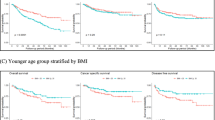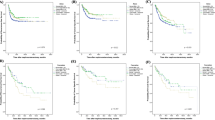Abstract
Purpose
To assess the relationship between body mass index (BMI) and survival outcomes in Korean patients with upper-tract urothelial carcinoma (UTUC).
Methods
A single-institutional retrospective analysis was conducted using clinical and pathological data of 445 UTUC patients who had undergone radical nephroureterectomy with bladder cuff excision from 1997 to 2012. Enrolled patients were classified into normal weight (BMI < 23 kg/m2), overweight (BMI 23–24.9 kg/m2), and obese (BMI ≥ 25 kg/m2) in accordance with BMI cutoffs for Asian populations. The impact of BMI on intravesical recurrence (IVR)-free survival, overall survival (OS), and cancer-specific survival (CSS) was evaluated using Kaplan–Meier analysis with the log-rank test and the Cox proportional hazard model.
Results
The median BMI of all patients was 24.2 kg/m2 (interquartile range 22.2–25.8). There were no significant differences in the IVR-free survival rates according to BMI classification (p = 0.488). The 5-year OS and CSS rates were 58.8, 66.3, and 76.3 % (p = 0.057) and 67.4, 69.3, and 81.5 % (p = 0.021) in the normal, overweight, and obese groups, respectively. In the univariate analysis, obesity (BMI ≥ 25 kg/m2) was a significant predictor of better OS [hazard ratio (HR) 0.63; 95 % confidence interval (CI) 0.43–0.92, p = 0.017] and CSS (HR 0.53; 95 % CI 0.33–0.84, p = 0.007) than normal weight. However, these associations could not be confirmed in the multivariable analysis after adjusting for other clinicopathological factors, such as tumor stage, tumor grade, lymphovascular invasion, and surgical margin.
Conclusions
Our study results are inconclusive, in that, the multivariate analysis did not identify the influence of BMI on survival, although higher BMI appears clinically associated with favorable survival outcomes in Korean patients with UTUC.


Similar content being viewed by others
References
Wang Y, Beydoun MA (2007) The obesity epidemic in the United States—gender, age, socioeconomic, racial/ethnic, and geographic characteristics: a systematic review and meta-regression analysis. Epidemiol Rev 29:6–28
Kang HT, Shim JY, Lee HR, Park BJ, Linton JA, Lee YJ (2014) Trends in prevalence of overweight and obesity in Korean adults, 1998–2009: The Korean National Health and Nutrition Examination Survey. J Epidemiol 24:109–116
Oh SW, Shin SA, Yun YH, Yoo T, Huh BY (2004) Cut-off point of BMI and obesity-related comorbidities and mortality in middle-aged Koreans. Obes Res 12:2031–2040
Tan K (2004) Appropriate body-mass index for Asian populations and its implications for policy and intervention strategies. Lancet 363:157–163
Oh SW (2011) Obesity and metabolic syndrome in Korea. Diabetes Metab J 35:561–566
Calle EE, Rodriguez C, Walker-Thurmond K, Thun MJ (2003) Overweight, obesity, and mortality from cancer in a prospectively studied cohort of US adults. N Engl J Med 348:1625–1638
Calle EE, Kaaks R (2004) Overweight, obesity and cancer: epidemiological evidence and proposed mechanisms. Nat Rev Cancer 4:579–591
Dal Maso L, Zucchetto A, Talamini R et al (2008) Effect of obesity and other lifestyle factors on mortality in women with breast cancer. Int J Cancer 123:2188–2194
Jee SH, Yun JE, Park EJ et al (2008) Body mass index and cancer risk in Korean men and women. Int J Cancer 123:1892–1896
Donat SM, Salzhauer EW, Mitra N, Yanke BV, Snyder ME, Russo P (2006) Impact of body mass index on survival of patients with surgically treated renal cell carcinoma. J Urol 175:46–52
Parker AS, Lohse CM, Cheville JC, Thiel DD, Leibovich BC, Blute ML (2006) Greater body mass index is associated with better pathologic features and improved outcome among patients treated surgically for clear cell renal cell carcinoma. Urology 68:741–746
Gong Z, Agalliu I, Lin DW, Stanford JL, Kristal AR (2007) Obesity is associated with increased risks of prostate cancer metastasis and death after initial cancer diagnosis in middle-aged men. Cancer 109:1192–1202
Koo K, Yoon Y, Rha K, Chung B, Yang S, Hong S (2014) Low body mass index is associated with adverse oncological outcomes following radical prostatectomy in Korean prostate cancer patients. Int Urol Nephrol 46:1935–1940
Hafron J, Mitra N, Dalbagni G, Bochner B, Herr H, Donat SM (2005) Does body mass index affect survival of patients undergoing radical or partial cystectomy for bladder cancer? J Urol 173:1513–1517
Chromecki TF, Cha EK, Fajkovic H et al (2013) Obesity is associated with worse oncological outcomes in patients treated with radical cystectomy. BJU Int 111:249–255
Kwon T, Jeong IG, You D et al (2014) Obesity and prognosis in muscle-invasive bladder cancer: the continuing controversy. Int J Urol 21:1106–1112
Rouprêt M, Babjuk M, Compérat E et al (2013) European guidelines on upper tract urothelial carcinomas: 2013 update. Eur Urol 63:1059–1071
Lughezzani G, Burger M, Margulis V et al (2012) Prognostic factors in upper urinary tract urothelial carcinomas: a comprehensive review of the current literature. Eur Urol 62:100–114
Verhoest G, Shariat S, Chromecki T et al (2011) Predictive factors of recurrence and survival of upper tract urothelial carcinomas. World J Urol 29:495–501
Ehdaie B, Chromecki TF, Lee RK et al (2011) Obesity adversely impacts disease specific outcomes in patients with upper tract urothelial carcinoma. J Urol 186:66–72
Bachir BG, Aprikian AG, Izawa JI et al (2014) Effect of body mass index on the outcomes of patients with upper and lower urinary tract cancers treated by radical surgery: results from a Canadian multicenter collaboration. Urol Oncol 32:441–448
Inamoto T, Komura K, Watsuji T, Azuma H (2012) Specific body mass index cut-off value in relation to survival of patients with upper urinary tract urothelial carcinomas. Int J Clin Oncol 17:256–262
Liu J-Y, Li Y-H, Liu Z-W et al (2014) Influence of body mass index on oncological outcomes in patients with upper urinary tract urothelial carcinoma treated with radical nephroureterectomy. Int J Urol 21:135–142
Kim M, Moon KC, Choi WS et al (2015) Prognostic value of systemic inflammatory responses in patients with upper urinary tract urothelial carcinoma. World J Urol. doi:10.1007/s00345-015-1484-9
Kikuchi E, Margulis V, Karakiewicz PI et al (2009) Lymphovascular invasion predicts clinical outcomes in patients with node-negative upper tract urothelial carcinoma. J Clin Oncol 27:612–618
Hursting SD, Dunlap SM (2012) Obesity, metabolic dysregulation, and cancer: a growing concern and an inflammatory (and microenvironmental) issue. Ann NY Acad Sci 1271:82–87
Kundu JK, Surh Y-J (2012) Emerging avenues linking inflammation and cancer. Free Radic Biol Med 52:2013–2037
Gilbert CA, Slingerland JM (2013) Cytokines, obesity, and cancer: new insights on mechanisms linking obesity to cancer risk and progression. Annu Rev Med 64:45–57
Acknowledgments
This study design and the use of patients’ information stored in the hospital database were approved by the Institutional Review Board (IRB) at the Seoul National University Hospital. The approval number is H-1503-099-657. We were given exemption from obtaining informed consent by the IRB because the present study is a retrospective study and personal identifiers were completely removed and the data were analyzed anonymously. Our study was conducted according to the ethical standards laid down in the 1964 Declaration of Helsinki and its later amendments. There were no grants or other external funding sources for this study.
Author information
Authors and Affiliations
Corresponding author
Ethics declarations
Conflict of interest
All the authors declare no conflicts of interest.
Electronic supplementary material
Below is the link to the electronic supplementary material.
11255_2015_1039_MOESM2_ESM.docx
Fig. 1. Kaplan–Meier plots for intravesical recurrence free survival in accordance with BMI classification of the entire study cohort. (DOCX 34 kb)
11255_2015_1039_MOESM1_ESM.tif
Table 1. Univariable and multivariable Cox regression analyses predicting intravesical recurrence free survival in the entire study cohort. (TIFF 1737 kb)
Rights and permissions
About this article
Cite this article
Kim, H.S., Jeong, C.W., Kwak, C. et al. Can body mass index predict survival outcomes in patients treated with radical nephroureterectomy for upper-tract urothelial carcinoma?. Int Urol Nephrol 47, 1311–1320 (2015). https://doi.org/10.1007/s11255-015-1039-4
Received:
Accepted:
Published:
Issue Date:
DOI: https://doi.org/10.1007/s11255-015-1039-4




